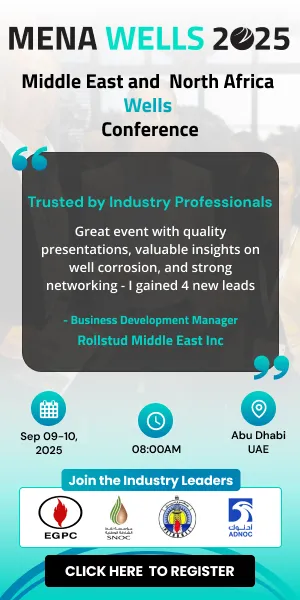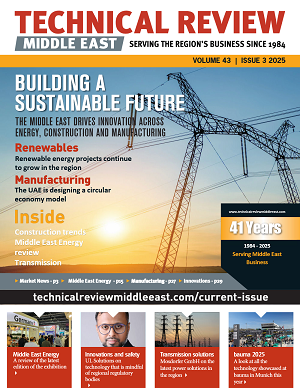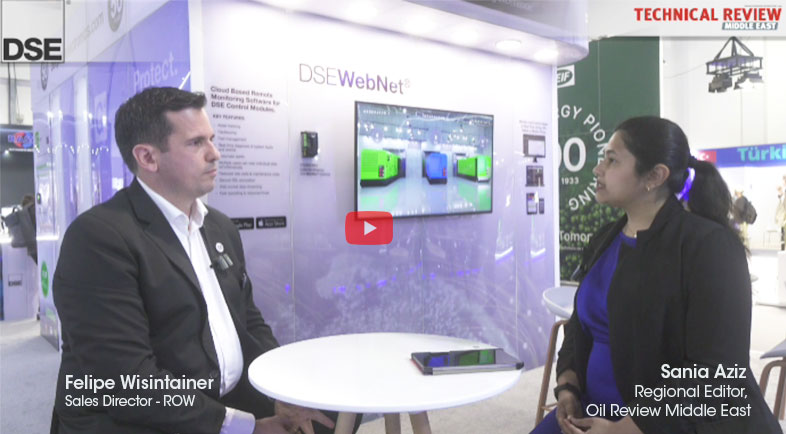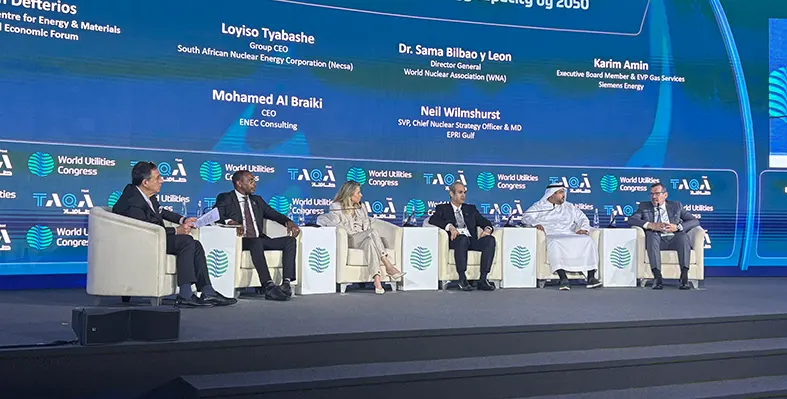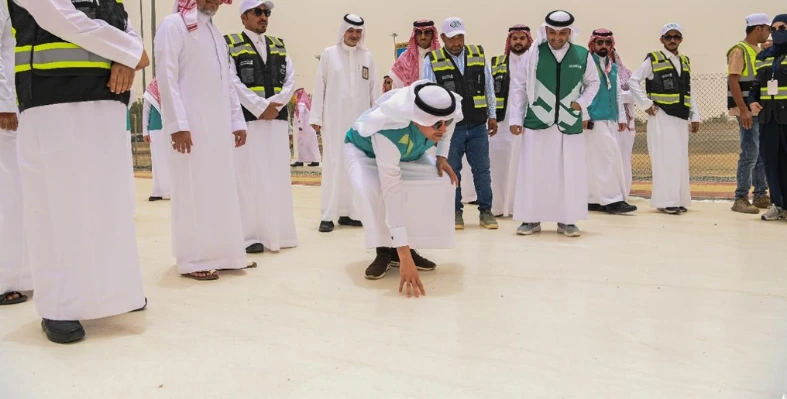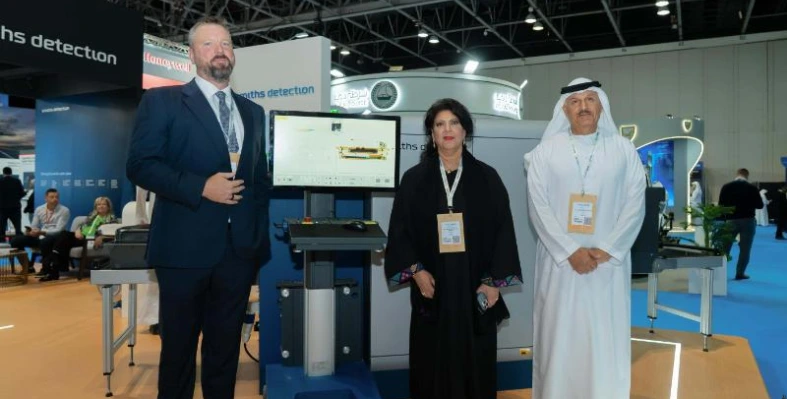In The Spotlight
Beneath the lively streets of Cairo, a technically ambitious infrastructure project is taking shape with the construction of the new Giza Station on Metro Line 4 – set to be one of the deepest metro stations in North Africa, reaching depths of up to 81 m.
Orascom Construction PLC has tasked BAUER EGYPT S.A.E., a subsidiary of BAUER Spezialtiefbau GmbH, with carrying out specialist foundation engineering works. Construction began in November 2024 and is scheduled for completion by December 2025.
Two special foundation techniques are in use: approx. 49,000 m² of diaphragm walls and 7,400 m² of barrettes, some reaching 81 m in depth.
A BAUER MC 96 duty-cycle crane is being deployed in double shifts, six days a week.
As of May 2025, 84 out of 209 diaphragm wall panels have been completed. The full station will span around 5,543 m².
“At this size and depth, there’s zero tolerance for deviation – every centimetre counts,” said Karim Galal, project manager at Bauer Egypt.
“The BAUER Construction Process provides us with a clear structure and guidance. It ensures that everyone involved in the project works to the same standards and helps us achieve our goals on time.”
Tight space and coordination constraints mark this project. Parts of the site are still in use until November 2025 to backfill an existing tunnel, allowing for further excavation.
“We’re working under highly unusual conditions with extremely tight space and immense time pressure,” Galal said. Notably, the tunnel boring machines are operating one above the other, a first in Egypt.
“The logistics, the depth, and the constant coordination with other trades present daily challenges, but that’s exactly what makes this project so special,” added Galal. The foundation engineering phase is expected to wrap up by year-end, paving the way for a significant upgrade to Cairo’s urban mobility.
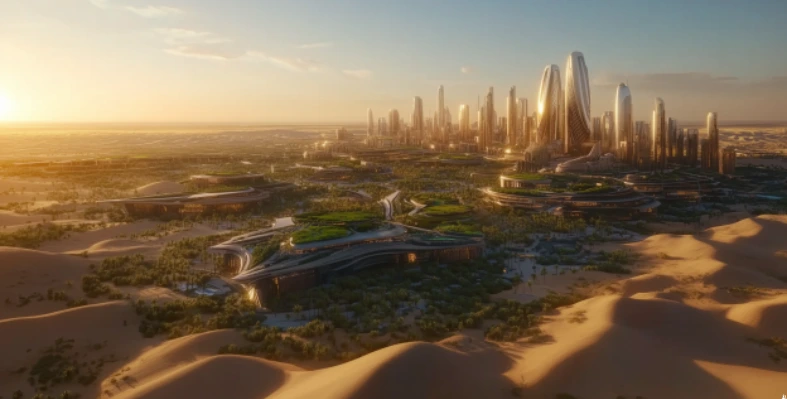
Egypt stands to benefit most from investing in energy-efficient construction. (Image source: Exergio)
Investing in energy-efficient buildings could yield enormous economic benefits for countries across the MENA, according to new research from the BUILD_ME initiative.
The analysis, which focused on Egypt, Jordan, and Lebanon, found that for every €1 spent on energy efficiency today, governments and consumers could see returns of up to €7 in the future.
The study identified 14 distinct co-benefits linked to energy-efficient buildings, including reduced energy bills, improved public health, job creation, and lower emissions.
Using just five indicators like energy cost reductions, healthcare savings, improved indoor comfort, lower public subsidies, and employment growth, the analysis projected significant macroeconomic gains.
Egypt stands to benefit most from investing in energy-efficient construction, with potential savings exceeding €18 billion.
These gains would stem from reduced electricity consumption, fewer pollution-related health issues, and greater productivity among workers.
Lebanon’s projected savings are even higher, at around €23 billion, driven largely by cutting energy bills in residential buildings, lowering emissions, and decreasing reliance on diesel generators.
Jordan, while showing more modest figures, could still save approximately €2.5 billion by reducing electricity demand and improving air quality in buildings.
“Egypt, Jordan, and Lebanon offer a snapshot of a much larger trend unfolding across MENA,” according to Donatas Karčiauskas, CEO of Exergio, a company developing AI-powered tools for optimising energy use in commercial buildings.
“We see similar dynamics in Oman and other Gulf countries, where extreme temperatures, growing cities, and strained energy systems are forcing to rethink how buildings are designed, renovated, and managed.”
This growing focus on energy efficiency in the region is not just an environmental imperative, but also a strategic response to rising energy demand, extreme temperatures, and the mounting climate crisis, according to Karčiauskas.
Governments across the Middle East and North Africa are now backing these efforts with new policies that promote greener, more sustainable construction.
In Egypt, revised energy efficiency standards for common household appliances such as air conditioners and televisions came into effect in January 2024, signalling a shift toward stricter regulation.
Jordan has launched its Third National Energy Efficiency Action Plan (2024–2026), building on previous efforts to reduce consumption across multiple sectors.
Lebanon, meanwhile, has introduced the Lebanon Green Building Council, which plays a key role in promoting sustainable building practices.
The urgency of this shift is clear. Buildings in Egypt, Jordan, and Lebanon are among the largest consumers of energy and contributors to carbon emissions, accounting for between 20% and 35% of each country’s total CO₂ output.
In addition, poor air quality stemming from inefficient housing continues to impose a heavy financial and health burden, costing governments and citizens billions every year.
But the opportunity is equally substantial. If just 30% to 50% of new residential and commercial complexes were constructed according to energy-efficient standards, the region could cut more than 80 million tonnes of CO₂ emissions, save upwards of €20 billion in energy costs, and generate close to 200,000 jobs over the next 20 years.
“The projected numbers mean that we need to scale energy-efficient construction rapidly and strategically. Prioritising digital retrofits can unlock immediate energy savings at lower costs, while targeted deep renovations should focus on the highest-impact buildings. For MENA, a hybrid approach will be needed, but eventually, all buildings will have to optimise energy using AI tools due to the amount of data,” said Karčiauskas.
One real-world example of how AI-driven solutions can accelerate energy efficiency comes from Exergio’s work with the Ozas shopping centre in Lithuania.
By analysing the building management system and integrating real-time HVAC controls with machine learning capabilities, Exergio was able to optimise the centre’s energy use. The result: a 29% drop in electricity consumption and a 36% reduction in heating demand, translating into nearly €1 million in cost savings.
According to Karčiauskas, this kind of outcome is only the beginning.
"In MENA countries – where high temperatures, year-round cooling needs, and energy subsidies shape the market – the potential is even greater. Faster payback periods, higher baseline consumption, and a growing push for smart solutions make this region one of the most promising places for large-scale energy efficiency gains," said Karčiauskas.
A report by Betterhomes suggests that the base 10% tariffs on the UAE levied by the Trump administration are unlikely to affect UAE industries
While the 25% tariffs imposed by the US on these key materials have created global uncertainty, Dubai’s diversified economy, robust trade infrastructure, and status as a re-export hub significantly cushion it from potential negative impacts.
In 2024, the UAE exported 350,000 tonnes of aluminium to the United States, making it the second-largest aluminium supplier to the American market. However, this relationship is unlikely to be substantially undermined by the tariffs. Unlike Canada and Mexico, the UAE has not been exempted from duties. Yet, the ongoing political engagement between the US and Gulf states signals room for bilateral negotiations, especially as the US looks to reduce dependence on Canadian imports.
Strategically, this opens a potential opportunity for the UAE to expand its aluminium exports to the US. Should a bilateral trade deal materialise, it could not only secure preferential access for Emirati aluminium but also strengthen the UAE’s role in global metal supply chains, particularly in sectors like aerospace, automotive, and defence.
Besides, the UAE’s domestic aluminium industry remains strong and well-positioned. With the US announcing a US$1.4tr investment in its own aluminium smelting capacity, future demand could shift more towards domestic consumption, but the high-quality aluminium produced in the UAE will likely remain competitive.
On the steel front, the US tariffs may trigger cost increases in international markets, but Dubai’s construction sector seems to be protected for now. As the UAE is not directly subject to reciprocal import duties on construction materials, price volatility will more likely be driven by currency fluctuations and shipping costs rather than trade restrictions. Moreover, Dubai’s construction pipeline remains vigorous, with more than 3,500 real estate and infrastructure projects underway.
A diversified economy
Dubai’s ongoing expansion in logistics and infrastructure, backed by a substantial government budget allocation (around AED 2.6 billion for transportation and logistics this year) supports sustained activity in the construction sector.
The city’s construction boom is not solely reliant on imported steel and aluminium from the US, as it sources materials from a diversified group of partners across Asia, Europe, and the broader MENA region. This geographical diversification further insulates Dubai from direct supply shocks related to US trade policies.
Another crucial factor is Dubai’s emergence as a global trade and transshipment hub. Free zones like Jebel Ali provide platforms for rerouting goods to avoid tariffs, enabling companies to adapt to shifting trade dynamics. This resilience reinforces Dubai’s attractiveness to investors and manufacturers seeking stability amidst geopolitical unpredictability.
Real estate continues to thrive. Despite macroeconomic pressures, April 2025 alone recorded AED 46 billion in real estate transactions, reflecting a 23% month-on-month surge.
Betterhomes reports that interest from US and Chinese investors rose sharply following the implementation of tariffs, with website traffic from these regions jumping by 60%. This renewed interest highlights how instability in one part of the world can enhance Dubai’s appeal as a stable, strategically located destination for capital investment.
While non-oil GDP in the UAE may slow down due to global trade turbulence, government policies aimed at diversification and innovation are already mitigating such risks. The Dubai Real Estate Strategy 2033 and the aim to double foreign direct investment to US$65bn by 2031 across sectors such as logistics, finance, and renewable energy show the country’s economic resilience.
In 2024, the world’s top 10 solar photovoltaic (PV) module manufacturers shipped a record 500 gigawatts (GW) of modules, nearly doubling the previous year’s volume, according to Wood Mackenzie’s Global Solar Module Manufacturer Rankings 2025 report.
Despite this milestone, the industry faced significant financial strain, with leading players reporting collective losses of US$4bn due to declining revenues and aggressive pricing.
For the Middle East, however, the report highlights a strategic pivot as manufacturers target the region for expansion to navigate global trade challenges and tap into growing demand.
The Middle East is becoming a critical growth frontier for solar PV manufacturers.
Wood Mackenzie notes that several top 20 manufacturers are planning to establish production facilities in Egypt, Oman, Saudi Arabia, Qatar, and the UAE.
This move is driven by the need to diversify geographically amid rising trade tensions and market barriers globally.
“Establishing production in the Middle East allows manufacturers to bypass tariffs, meet local content mandates, and capitalise on the region’s increasing solar adoption,” said Yana Hryshko, head of global solar supply chain at Wood Mackenzie. “It’s a strategic play to remain competitive in a fragmented global market.”
The push into the Middle East aligns with the region’s ambitious renewable energy targets, particularly in Saudi Arabia and the UAE, where solar projects are scaling rapidly.
By setting up local production, manufacturers aim to secure a foothold in these high-growth markets while mitigating risks from import restrictions and trade policies elsewhere.
Top manufacturers leading the charge
The 2024 rankings, led by Jinko Solar (90.6/100), JA Solar (89.8), and LONGi Green Energy (86.5), reflect the dominance of Chinese manufacturers, but the report underscores the growing geographic diversification of production.
Seven of the top 10 manufacturers now operate facilities in three or more countries, with the Middle East emerging as a key focus alongside regions like Cambodia, India, Malaysia, Mexico, and Vietnam.
The top 10 manufacturers maintained a robust average utilisation rate of 69%, showcasing operational resilience despite market pressures.
Their focus on the Middle East is expected to strengthen supply chains tailored to regional needs, particularly as demand for high-efficiency N-type modules grows.
The industry’s shift to N-type modules, which accounted for over 87% of Jinko Solar’s shipments, is particularly relevant for the Middle East, where high-efficiency technologies like TOPCon (24%+ efficiency) and heterojunction (HJT, 24%) are well-suited to the region’s harsh climatic conditions.
Additionally, top manufacturers are pursuing vertical integration, with investments in wafer production to control costs and quality—an advantage for establishing cost-competitive operations in the Middle East.
As solar PV module prices remain under pressure, the Middle East offers a strategic opportunity for manufacturers to balance cost reduction with market expansion.
The region’s growing solar market, supportive policies, and strategic location make it a pivotal hub for the industry’s next growth cycle.
“Despite financial challenges, the solar industry is repositioning for global growth, with the Middle East playing a central role,” Hryshko concluded. “Technology leadership, supply chain control, and regional agility will define success in this dynamic market.”

Sri Lanka's water management challenges have drawn international attention. (Image source: Alain Charles Publishing)
In an era of increasing water scarcity and climate uncertainty, the UAE has emerged as a critical partner for island nations struggling with water security challenges.
A recent panel during the World Utilities Congress in Abu Dhabi highlighted the UAE's role in supporting Cyprus and Sri Lanka through technological assistance.
Cyprus, facing its most severe drought in three decades, received immediate and tangible support from the UAE.
Maria Panayiotou, Minister of Agriculture, Rural Development, and Environment, emphasised this, stating, "Two days ago, Cyprus received desalination units of 15,000 cubic meters production of water per day. We have asked for help from the UAE, and the UAE responded positively. [It] responded immediately."
This gesture is more than a simple aid package; it represents a sophisticated approach to transboundary water cooperation.
Panayiotou described it as "a tremendous help for Cyprus" that faces prolonged drought and severe water scarcity.
The desalination units are part of Cyprus's broader strategy to achieve 100% water coverage by the end of the year, with a focus on using renewable energy and solar systems to reduce production costs.
Global South countries collaborate with each other
Similarly, Sri Lanka's water management challenges have drawn international attention.
While the country boasts over 100 rivers and significant rainfall, political and infrastructural issues have complicated water distribution.
The UAE's collaborative approach extends beyond immediate relief, supporting comprehensive water management strategies.
Both Cyprus and Sri Lanka view the UAE's support through a lens of regional cooperation and geopolitical partnership.
As Panayiotou put it, "We act locally, but you have to think globally and cooperate regionally. This is important. We cannot do it by ourselves."
The support goes beyond mere technological transfer. It represents a model of diplomatic engagement where resource-rich nations assist countries facing environmental challenges.
Anil Jayantha from Sri Lanka emphasised the importance of collaborative approaches, noting that solutions require working "together with all other ministries and international agencies."
As climate change continues to challenge traditional water management approaches, the UAE's support for Cyprus and Sri Lanka offers a blueprint for international cooperation.
It underscores the potential of strategic partnerships in addressing one of the most critical challenges of the 21st century: ensuring water security for vulnerable nations.

Volvo CE machines prove superior in Gulf trials, showcasing productivity, safety, and fuel efficiency gains. (Image source: Volvo CE)
Following the launch of its next-generation excavators for the Middle East and Africa, Volvo Construction Equipment (Volvo CE) recently validated their on-site performance through rigorous comparative testing in the Gulf region
The models – EC210, EC220, and EC360 – went head-to-head with competing machines from top global OEMs in real-world truck loading tasks, assessed on key metrics including productivity, fuel efficiency, durability, operator comfort, safety, and serviceability.
All machines were tested under identical site conditions using a dig-swing-dump-repeat cycle. Operators included a Volvo R&D veteran with 15 years of experience and two local contractors with a combined 22 years of excavator operation. The consistent conditions ensured fair performance evaluation across all brands.
EC210: Power meets precision in 22-tonne class
Delivering stronger productivity and improved fuel efficiency — even at lower RPMs.
In the 22-tonne category, the EC210 stood out by achieving up to 7% greater productivity and 14% better fuel efficiency than rivals in the same weight class. Despite operating at lower RPMs, the machine demonstrated optimal power-to-efficiency balance, making it ideal for applications like roadworks, site preparation, and utilities. "It’s a compact powerhouse, especially for contractors focused on output without excessive fuel costs," said Olle Watz, product manager at Volvo CE Region International.
EC220: Boosted output for bigger demands
Strikes a balance between power and fuel economy in high-volume operations.
The EC220 built upon the EC210’s strengths, boasting a 32% increase in productivity while maintaining comparable fuel usage. Its higher output makes it suitable for heavy-duty tasks like bulk excavation and materials handling. According to Watz, “The EC220 delivers high return where speed and volume matter without compromising efficiency.”
EC360: Bigger Isn’t always better
Outpaces larger rivals in productivity and efficiency, even at reduced RPM.
The heavyweight EC360 surprised testers by outmatching larger-class competitors. Despite running at a fuel-saving 1,500 RPM, it achieved up to 25% higher productivity and 21% greater fuel efficiency compared to competitors operating at peak RPM. “This model proves that thoughtful design can outperform brute force,” noted Watz.
Smart design, safer sites
From ROPS cabs to enhanced visibility, safety is built in from the ground up.
Safety features were a key differentiator. Volvo was the only OEM to offer a ROPS-certified cab as standard. Added elements like deck lighting, slip-resistant surfaces, smartly placed handrails, and a built-in rear-view camera highlighted the brand’s operator-first approach. Test operators praised visibility and ergonomic layouts that reduced fatigue over long shifts.
Serviceability with uptime in mind
Ground-level access, smart layout, and maintenance-friendly features keep jobs moving.
Ease of maintenance also played a role in Volvo CE’s top scores. Features like a smaller engine hood, improved ground-level access to service points, and anti-clog track holes make daily upkeep simpler and faster — critical in the demanding environments of the Middle East and Africa.
These real-world trials not only reaffirm Volvo CE’s engineering direction but underscore its ability to deliver reliable, cost-effective solutions that meet the region’s harsh worksite demands.
In the high-pressure world of mining, quarrying, and construction, fuel efficiency is a make-or-break factor for both profitability and environmental impact.
Garry Moore, a veteran customer support manager at Rokbak, a Scottish manufacturer of articulated dump trucks (ADTs), has spent nearly 20 years refining strategies to optimise heavy equipment performance.
Here, Moore unveils seven expert tips for harnessing Rokbak’s Haul Track telematics system to slash fuel expenses, curb carbon emissions, and boost site productivity.
Here are seven ways to achieve it
1. Keep engines in top shape for fuel savings
A neglected engine burns more fuel and pumps out excess emissions. Haul Track’s real-time diagnostics alert managers to issues like blocked filters or suboptimal fuel systems, enabling quick fixes. By acting on these email notifications, operators ensure ADTs run lean, saving fuel and reducing environmental harm.
2. Spot and fix delays with idling insights
Trucks idling in queues waste fuel and stall progress. Using Haul Track’s GPS and idle-time tracking, managers can identify bottlenecks where ADTs wait for loaders. Moore suggests rebalancing fleet setups—adjusting loader or hauler sizes—to keep operations moving, cutting fuel use and CO2 output while ramping up efficiency.
3. Maximise loads with precision weighing
Half-empty trucks force extra trips, inflating fuel costs and equipment wear. Rokbak’s On-Board Weigh, synced with Haul Track, provides live load data, empowering operators to fill trucks to capacity every time. This approach boosts output, conserves fuel, and keeps production targets on track.
4. Redesign sites for shorter, smarter routes
Inefficient haul roads and traffic snarls sap fuel economy. Haul Track’s movement tracking, combined with fuel and idle reports, works across all equipment brands to highlight trouble spots. By streamlining routes and easing congestion, managers can trim fuel bills, lower emissions, and extend machine life.
5. Coach operators for smoother driving
Aggressive driving habits, like rapid acceleration or sudden stops, can inflate fuel consumption. Haul Track’s fuel usage comparisons reveal when specific trucks burn more than peers on similar tasks. Moore advocates using these insights for constructive training, helping drivers adopt smoother techniques to save fuel.
6. Protect tyres, save fuel
Underinflated tyres increase drag, forcing engines to work harder and wear out faster. Haul Track’s real-time tyre pressure monitoring catches issues early, allowing quick corrections. Proper inflation optimises fuel use, prolongs tyre durability, and enhances site safety.
7. Drive progress with clear performance goals
Haul Track’s robust data lets managers set fuel efficiency targets and monitor results over time. By analyzing trends and sharing feedback, teams stay motivated to improve. This data-driven approach fosters smarter decisions and a culture of continuous progress.
Moore’s strategies show that Haul Track is more than a data tool. It is a game-changer for cost-conscious, eco-aware operations. With these seven tactics, site leaders and operators can transform insights into action, driving down costs and emissions while keeping their sites running at peak performance.
In a Q&A with Technical Review Middle East, Moussalam Dalati, General Manager MEA & France – Liferay, speaks on digitalisation in the manufacturing sector. Read on:
How do Digital Experience Platforms (DXPs) drive digital transformation in the manufacturing sector?
Manufacturing is a prime industry for implementing Digital Experience Platforms (DXPs), given its complex B2B environment characterised by international operations, dynamic market demands, and intense competition. The manufacturing value chain involves numerous stakeholders from raw material suppliers to distributors and retailers, creating ample opportunities for technology to streamline operations and enforce process consistency.
For manufacturing companies, DXPs integrate a wide range of technologies to deliver streamlined digital interactions across the organisation. By unifying data from IoT sensors, ERP systems, and other enterprise platforms, DXPs enable seamless data access and analysis. This integration supports improved decision-making, cost optimisation, and greater operational efficiency throughout the manufacturing lifecycle.
What DXP solutions are most popular in manufacturing, and what drives their adoption?
In manufacturing, one of the most critical needs is robust B2B digital commerce that integrates seamlessly with broader self-service capabilities to deliver a unified digital customer experience. Liferay addresses this by combining native B2B commerce with powerful DXP features, enabling manufacturers to manage product catalogues, tutorials, knowledge bases, community forums, support tickets, and workflows on a single platform. Liferay DXP is especially well-suited for manufacturing scenarios, offering advanced features like Shop by Diagram (i.e., an interactive parts-diagram interface where technicians can click on components to order replacements), buyer approval workflows, contract pricing, and tiered discounts, all essential for complex B2B transactions. Manufacturers also face recurring challenges in reducing cost-to-serve, entering new markets, streamlining operations, and differentiating through customer experience.
How do DXPs support real-time analytics for predictive maintenance, quality control, and supply chain visibility?
DXPs consolidate structured and unstructured data from IoT devices, ERP systems, and production platforms into a single view. This single view provides clean, accessible data essential for powering AI-driven analytics. They also continuously collect sensor data. This enable early detection of equipment issues and support machine learning models that predict failures, reducing downtime and maximising asset performance.
Besides, real-time monitoring helps detect production deviations, while historical data analysis identifies patterns that may lead to defects. This proactive approach improves product quality and minimises waste. With easy-to-integrate AI capabilities, DXPs support predictive models for everything from energy efficiency to production optimisation, driving continuous improvement and competitive advantage.
How can DXPs integrate with existing ERP and manufacturing systems without disrupting operations?
As organisations scale, their existing investments in content, marketing, and customer management systems can become fragmented, resulting in siloed data and disjointed customer experiences. The high cost and complexity of replacing legacy systems often delay digital transformation initiatives that are critical to delivering seamless, connected experiences. Digital Experience Platforms (DXPs) like Liferay offer a strategic solution. Rather than replacing existing systems, Liferay DXP integrates and extends them, enabling companies to unify the customer journey across touchpoints.
With out-of-the-box capabilities for content management, personalisation, and customer engagement, DXPs provide a modern, cohesive experience layer while preserving legacy infrastructure in the background.
These platforms are built for flexibility, supporting both current business needs and future innovation. As a result, more companies each year are turning to DXPs to simplify the experience, modernize systems and break down silos to accelerate digital transformation at scale.
IVECO and Ital Car SA showcased the full IVECO vehicle range to the Tunisian market at the 18th edition of Le Salon Méditerranéen du Bâtiment (MEDIBAT), held from 21-24 May 2025 in Sfax.
The brands highlighted IVECO’s robust offering tailored to meet the toughest business challenges across the construction and transport sectors.
MEDIBAT is one of the largest construction events in the Mediterranean region, attracting key players from across the industry, including international delegations, architects, public and private project owners, and solution providers. The exhibition served as a platform for innovation, professional networking, and the promotion of cutting-edge technical solutions.
At the event, Ital Car SA introduced the IVECO T-Way AT720T43TH 6x4 heavy-duty truck to the Tunisian market. As the successor to the Trakker, the T-Way delivered enhanced capabilities across all performance areas. The stand also featured the Eurocargo ML180E28 4x2, known for its versatility in logistics and urban transport, and the Daily 70C15 chassis cab, a flexible solution for light to medium transport needs.
Ital Car SA’s stand spanned 152 square metres and welcomed over 100 guests, including government officials, media, and customers.
Kais Krima, managing director of Ital Car SA, commented, “MEDIBAT is a strategic event for us. It showcases our expertise in the Tunisian market and an opportunity to reaffirm IVECO's position as a key player in the construction and industrial transport sector. We are pleased to show to our customers and guests these robust, reliable models that are suitable for all missions and terrains.”
Mechim Hichem, IVECO business manager for Tunisia, added, “We at IVECO are very happy and pleased to be present here alongside our excellent and valued partner at Ital Car SA, especially in this special year, while IVECO is celebrating 50 years, we are together with our historic partner Ital Car SA with 50 years of IVECO's history in the market, as one of our most important dealers in African and Tunisian territory. Together, we are presenting our full selection and range of vehicles, which includes our light, and heavy-duty models and options, all designed to meet the different needs of our customers right here in Sfax. It's truly fantastic and wonderful to see so many of you have come to visit and have joined us these days. We want to say a sincere thank you all for being here and for your trust on the IVECO quality and performance.”
Ital Car SA is an official IVECO dealer in Tunisia, offering the full vehicle range through a direct sales force and after-sales services from its base in Megrine. With active operations in Tunis and a national network of sub-distributors, Ital Car SA employs nearly 200 people. The company prides itself on close customer relationships, technical expertise, and responsive service.
IVECO T-Way: built for the toughest jobs
The IVECO T-Way was developed for extreme off-road performance, productivity, and reliability. It builds on the legendary Trakker platform, offering a reinforced high-strength steel chassis with a 10mm thick frame and a top-tier Rail Bending Moment of 177 kNm. The front axle supports up to 9 tonnes, while the rear hub reduction maximises load capacity and durability.
Equipped with a new heavy-duty rear suspension for tandem axles, the T-Way improved off-road agility and clearance. It also featured the Cursor 13 engine producing up to 470hp, paired with the HI-TRONIX 16-speed automated gearbox. Key driving features included Hill Holder, Rocking Mode, Creep Mode, and Ecoroll to optimise traction, control, and efficiency in all terrain and traffic conditions.
Eurocargo: a multi-purpose logistics champion
Eurocargo demonstrated its reliability and flexibility across multiple missions, offering over 11,000 configurations including seven gross vehicle weight classes, four power ratings, three cab types, and seven gearbox options. Updates included LED Daytime Running Lights, Xenon headlamps, an aerodynamic front deflector, and a UV-filtering windscreen. Its ergonomic design allowed for easier cleaning and safer night-time operations.
Daily: the industry’s most versatile light commercial vehicle
The Daily remained the most customisable vehicle in its class, with gross vehicle weights from 3.5 to 7.2 tonnes and wheelbases from 3,000 to 5,100 mm. Its flexibility made it ideal for demanding tasks, including ambulances and rescue vehicles.
It also introduced a new generation of memory foam driver seats, designed for ergonomic support, reduced pressure, and increased comfort.
Thicker side padding, longer cushions, and reworked levers made entry and exit easier, particularly for delivery and door-to-door missions.










